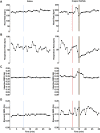Physiological changes associated with copper sulfate-induced nausea and retching in felines
- PMID: 36744037
- PMCID: PMC9892644
- DOI: 10.3389/fphys.2023.1077207
Physiological changes associated with copper sulfate-induced nausea and retching in felines
Abstract
Nausea is a common disease symptom, yet there is no consensus regarding its physiological markers. In contrast, the process of vomiting is well documented as sequential muscular contractions of the diaphragm and abdominal muscles and esophageal shortening. Nausea, like other self-reported perceptions, is difficult to distinguish in preclinical models, but based on human experience emesis is usually preceded by nausea. Here we focused on measuring gastrointestinal and cardiorespiratory changes prior to emesis to provide additional insights into markers for nausea. Felines were instrumented to chronically record heart rate, respiration, and electromyographic (EMG) activity from the stomach and duodenum before and after intragastric delivery of saline or copper sulfate (CuSO4, from 83 to 322 mg). CuSO4 is a prototypical emetic test agent that triggers vomiting primarily by action on GI vagal afferent fibers when administered intragastrically. CuSO4 infusion elicited a significant increase in heart rate, decrease in respiratory rate, and a disruption of gastric and intestinal EMG activity several minutes prior to emesis. The change in EMG activity was most consistent in the duodenum. Administration of the same volume of saline did not induce these effects. Increasing the dose of CuSO4 did not alter the physiologic changes induced by the treatment. It is postulated that the intestinal EMG activity was related to the retrograde movement of chyme from the intestine to the stomach demonstrated to occur prior to emesis by other investigators. These findings suggest that monitoring of intestinal EMG activity, perhaps in combination with heart rate, may provide the best indicator of the onset of nausea following treatments and in disease conditions, including GI disease, associated with emesis.
Keywords: copper sulfate; gastric electromyogram; heart rate; nausea; respiratory activity detection; vomiting.
Copyright © 2023 Murphey, Shulgach, Amin, Douglas, Bielanin, Sampson, Horn and Yates.
Conflict of interest statement
The authors declare that the research was conducted in the absence of any commercial or financial relationships that could be construed as a potential conflict of interest.
Figures






Similar articles
-
Delineation of vagal emetic pathways: intragastric copper sulfate-induced emesis and viral tract tracing in musk shrews.Am J Physiol Regul Integr Comp Physiol. 2014 Mar 1;306(5):R341-51. doi: 10.1152/ajpregu.00413.2013. Epub 2014 Jan 15. Am J Physiol Regul Integr Comp Physiol. 2014. PMID: 24430885 Free PMC article.
-
An acute experiment on retrograde intestinal peristalsis with emesis using decerebrated dogs.J Auton Nerv Syst. 1998 May 28;70(1-2):56-65. doi: 10.1016/s0165-1838(98)00028-9. J Auton Nerv Syst. 1998. PMID: 9686904
-
Machine learning prediction of emesis and gastrointestinal state in ferrets.PLoS One. 2019 Oct 18;14(10):e0223279. doi: 10.1371/journal.pone.0223279. eCollection 2019. PLoS One. 2019. PMID: 31626659 Free PMC article.
-
Noxious stimulation of emesis.Dig Dis Sci. 1999 Aug;44(8 Suppl):58S-63S. Dig Dis Sci. 1999. PMID: 10490041 Review.
-
Digestive tract motor correlates of vomiting and nausea.Can J Physiol Pharmacol. 1990 Feb;68(2):242-53. doi: 10.1139/y90-038. Can J Physiol Pharmacol. 1990. PMID: 2178749 Review.
Cited by
-
Which Environmental Pollutants Are Toxic to Our Ears?-Evidence of the Ototoxicity of Common Substances.Toxics. 2024 Sep 4;12(9):650. doi: 10.3390/toxics12090650. Toxics. 2024. PMID: 39330578 Free PMC article. Review.
-
Antiemetic activity of abietic acid possibly through the 5HT3 and muscarinic receptors interaction pathways.Sci Rep. 2024 Mar 19;14(1):6642. doi: 10.1038/s41598-024-57173-0. Sci Rep. 2024. PMID: 38503897 Free PMC article.
-
Synergistic Antiemetic Effects of Nerolidol on Domperidone, Hyoscine, and Ondansetron: In Vivo and in Silico Investigations on Receptor Binding Affinity.ChemistryOpen. 2025 Mar;14(3):e202400345. doi: 10.1002/open.202400345. Epub 2024 Nov 12. ChemistryOpen. 2025. PMID: 39533458 Free PMC article.
References
-
- Bielanin J. P., Douglas N. O., Shulgach J. A., McCall A. A., Miller D. M., Amin P. R., et al. (2020). Responses of neurons in the medullary lateral tegmental field and nucleus tractus solitarius to vestibular stimuli in conscious felines. Front. Neurol. 11 (1755), 620817. 10.3389/fneur.2020.620817 - DOI - PMC - PubMed
-
- Carson D. A., Bhat S., Hayes T. C. L., Gharibans A. A., Andrews C. N., O'Grady G., et al. (2022). Abnormalities on electrogastrography in nausea and vomiting syndromes: A systematic review, meta-analysis, and comparison to other gastric disorders. Dig. Dis. Sci. 67 (3), 773–785. 10.1007/s10620-021-07026-x - DOI - PubMed
Grants and funding
LinkOut - more resources
Full Text Sources

